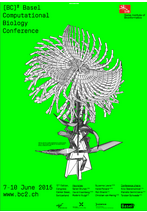WS1: Computational methods for high-dimensional single-cell mass cytometry data
Organizers:
Bernd Bodenmiller (University of Zürich), Magnus Rattray (University of Manchester), Mark Robinson (University of Zürich)
Workshop website
Workshop Summary:
Background. Breakthroughs in technology are facilitating the detailed study of single cells on a large scale. One new and promising technology, which is now commercialized by Fluidigm, is the CyTOF 2 Mass Cytometer. This instrument allows simultaneous detection of 30+ proteins with capacity to measure well over 100. The technology is driving new avenues of discovery and understanding in single-cell biology with the ability to characterize cell type, function and signaling across a mixed population of cells from a single assay. The technology combines antibodies that are conjugated to stable metal isotopes with time-of-fight mass spectrometry; essentially, a 30+ dimensional measurement is taken on every cell processed. There is already a large body of methods available for the processing and analysis of this data, such as SPADE and viSNE for clustering and visualization, infrastructure in Bioconductor for preprocessing such as OpenCyto, finding cell population signatures using 'citrus' and many new tools are becoming available through online resources, such as CytoBank. Given the excitement and potential of this relatively new technology and the rapid development of data analysis tools, it is timely to bring together researchers, methodologists and new developers with interest in single cell technologies.
Expected goals. The workshop will bring together leading researchers working on computational tools in the single-cell analysis space, with specific emphasis on methods for ow and mass cytometry data. Our aim is to help method developers and users better understand the relative merits of current tools, to present new ideas and facilitate possibilities for community-based benchmarking of the technology. The workshop will cover current statistical and computational challenges, such as:
- Normalization with bead standards
- Dimensionality reduction and visualization techniques
- Methods for inferring di erences in replicates of cell populations
- Clustering methods for single cell data
Target audience. Computational biologists, statisticians, genome biologists with an interest in data analysis and statistical methods for high-dimensional (mass cytometry-based) single cell experiments.
Workshop Agenda & Speakers:
- Please check the workshop website






